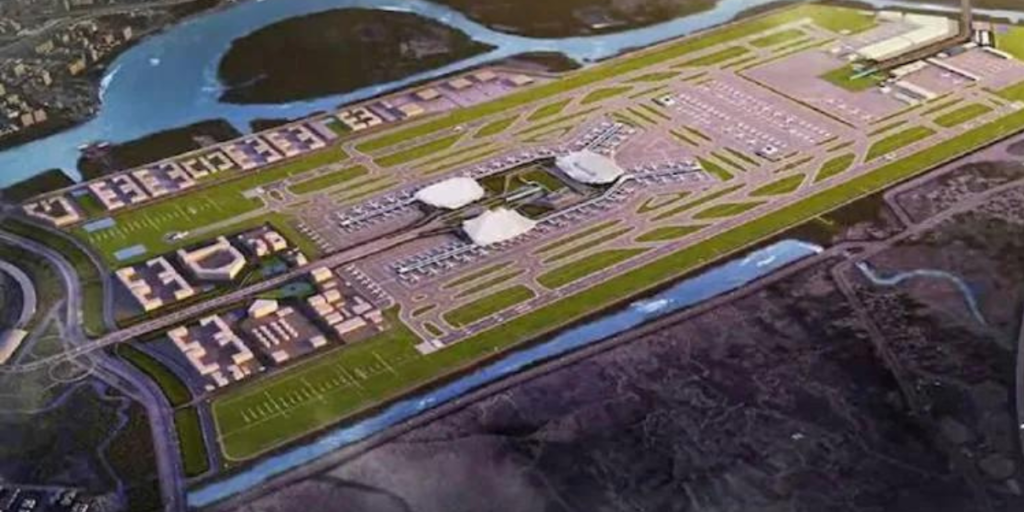The inauguration of the Ayodhya Airport, also known as Maharishi Valmiki International Airport, is a momentous occasion set to take place on December 30, 2023. This airport, designed to reflect the cultural opulence of Ayodhya, signifies more than just a transport hub. With a strategic location and an architectural concept deeply rooted in the Hindu epic Ramayana, the Ayodhya Airport aims to become a gateway to the historic city, particularly the upcoming Ayodhya Ram Mandir. This blog explores the significance of Ayodhya Airport, its cultural reflection in design, economic impact, and the broader vision for the development of Ayodhya.

Table of Contents
Significance of Ayodhya Airport:
1. Cultural Opulence and Religious Connotations
The Ayodhya Airport holds immense significance due to its cultural and religious connotations. It is not merely an aerodrome but a cultural spot inspired by the rich heritage of Ayodhya. The design of the airport is a modern architectural marvel that mirrors the city’s history, with elements inspired by the life of Lord Ram. The Nagara architectural style, murals depicting scenes from the Ramayana, and engravings showcasing the city’s cultural influence contribute to making the airport a symbolic representation of Ayodhya’s spiritual and historical impact.
2. Gateway to Shri Ram Mandir
Strategically located, the airport is designed to cater to pilgrims, tourists, and devotees, providing them with a seamless travel experience as they visit the historic city of Ayodhya and the upcoming Ayodhya Ram Mandir. It is poised to become the gateway to Shri Ram Mandir, offering not only connectivity but also an immersive cultural experience for visitors.

Inauguration and Vision for Ayodhya:
1. Prime Minister Narendra Modi’s Vision
The inauguration of the Ayodhya Airport by Prime Minister Narendra Modi is a testament to the government’s commitment to developing world-class infrastructure and promoting economic growth in the region. This event is part of a broader vision, encompassing various projects worth ₹11,100 crore, including the Ayodhya Dham Junction Railway Station, new roads, and a greenfield township in Ayodhya. The redevelopment of Ayodhya Railway Station and the introduction of new trains further emphasize the commitment to improving connectivity.
2. Economic Impact and Job Creation
The Ayodhya Airport is projected to create at least 500 jobs annually, contributing significantly to the development of the local community and fostering sustainable livelihoods. The economic impact is not limited to job creation; it extends to the broader development of the region. The construction of the Ram Mandir has already proven to boost local businesses, creating a ripple effect that is expected to intensify with the addition of the Ayodhya Airport.
Cultural Reflection in Design:

1. Architectural Concept Rooted in Ramayana
The airport’s architectural concept is deeply rooted in the Ramayana, with various elements depicting scenes and characters from the epic. Murals and engravings showcase the life of Lord Ram, including significant events such as Hanuman’s life, the Ram Darbar, and the marriage of Lord Ram to Sita. This cultural integration makes the airport a unique and captivating cultural attraction.
2. Nagara Architectural Style
The use of the Nagara architectural style adds a distinct regional touch to the airport. Popular in the northern and western regions of India, this style enhances the airport’s cultural significance and creates a sense of connection with the local heritage.
3. Environmentally Friendly Design
The airport’s design incorporates environmentally friendly Glass Reinforced Concrete (GRC), minimizing pollution caused by traditional construction materials. This sustainable approach aligns with the airport’s commitment to preserving the environment and promoting eco-friendly infrastructure.
Conclusion:
In conclusion, the Ayodhya Airport is a transformative development for the region, offering not only a seamless travel experience but also contributing to economic growth and celebrating the rich cultural heritage of Ayodhya. The airport’s inauguration by Prime Minister Narendra Modi marks a significant milestone in the development of the region, positioning it as a major transport hub. As the airport becomes operational, it is expected to boost tourism, create job opportunities, and serve as a beacon of modern infrastructure deeply rooted in cultural and historical significance. Ayodhya Airport is not just an airport; it is a symbol of progress that honors the past while embracing the future.

